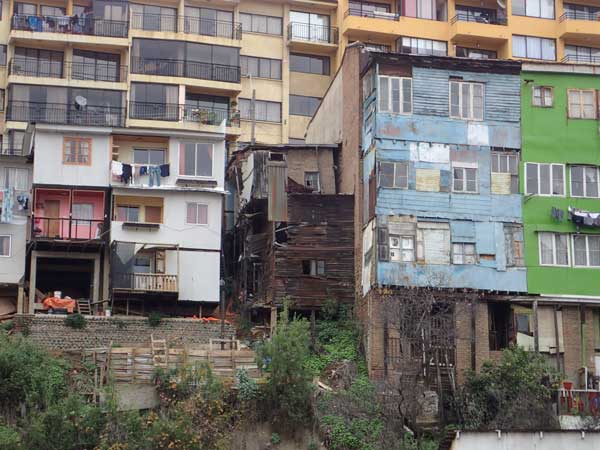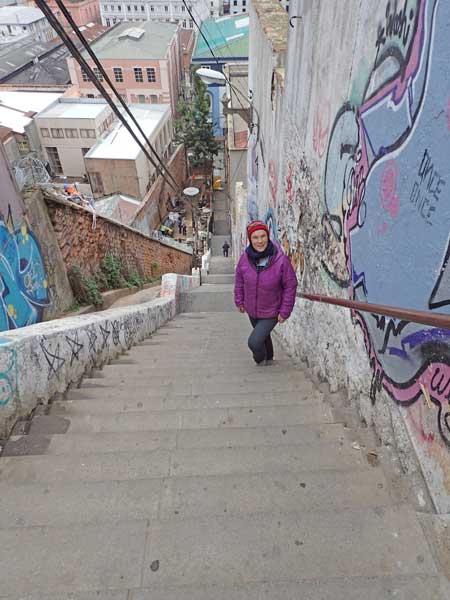Valparaiso

Caramor - sailing around the world
Franco Ferrero / Kath Mcnulty
Thu 22 Jun 2017 18:49
33:02.41S 71:37.35W It was mid-morning when the overnight bus pulled into Valparaíso. Blurry eyed we wandered vaguely in the direction of downtown. Franco stopped to ask a street hawker if we were going the right way and she just stared at him coldly. Luckily for us, another seller stepped in to give us directions. We found a restaurant serving breakfast. As we walked in, the waiter thrust menus at us without even a look or a greeting. “Welcome to Valparaíso!” We thought. Our Chilean friends had warned us. “The north is unfriendly.” They had said, but Chile’s most famous port is only a few miles north of Santiago!  Crumbling ... A few months ago, Franco and I read Isabel Allende’s ‘Hija de la Fortuna’ (Daughter of Fortune), a powerful novel about the Californian gold rush. The first half of the book is set in Valparaíso and Allende’s narrative left me with a strong impression. This is how the story starts: ‘Victorian spinster Miss Rose lives with her brother Jeremy Sommers in Valparaíso’s British colony. A newborn baby is found on the doorstep of the Sommers’ mansion and Miss Rose adopts the child, naming her Eliza. Eliza grows up between Miss Rose who insists on piano lessons taken with a rod down her back, and Mama Fresia, the Mapuche cook who teaches her cookery and herbal medicine. One day Eliza meets Joaquín Andieta, a clerk working for her uncle, falls madly in love with him and they start an affair. It is 1849, gold has been found in California and Joaquín, like many other Chileans, has gold fever. He decides to set off to search for gold, is his only chance of making enough money to marry Eliza and support his mother. He departs for San Francisco and Eliza discovers she is pregnant …’ We were curious whether we would recognise the Valparaíso described in the book.  Cerro Alegre and the Lutheran church in the distance We’d booked a hostel near the city centre, and as we trudged towards it, were surprised by the amount of graffiti everywhere. I soon learnt that there are three types: The tag, the most ugly and primitive form. ‘Taggers’ seem to have little respect for anything.  A tag Graffiti, colourful but says what, exactly?  Graffiti The mural, a form of public art, often with a political message. Many of the artists have made a name for themselves and in Valparaíso, works are frequently commissioned by home-owners.  A mural As we approached downtown, the streets became constricted and the flat strip between the sea and the surrounding hills narrowed. Behind the graffiti were grand old buildings that had seen better times. We had arrived in the port quarter, which together with the hills Cerro Alegre and Cerro Concepción, form the UNESCO World Heritage site.  Grand houses in the port quarter - all very run down  The modern port  The old port, now filled with tourist boats The nomination recognises Valparaíso’s uniqueness, particularly that it retains many architectural features from the late 1800s. The city was founded in 1544 and the port became important after the discovery of the Cape Horn trade route. Ships would stop over to resupply and make repairs. With the independence of Chile in 1810, Valparaíso became the most important harbour on the Pacific coast. This meant commercial transactions with Europe as well as with the United States, ending Chile’s dependence on Spain. During the 1830s large numbers of immigrants from England, France, Germany, and the United States arrived, contributing to the development of shipping and commerce. With them came ideas, techniques and materials which led to rapid economic and industrial development. New homes were needed and the town expanded organically up the surrounding hills. Each community needed a place of worship and the result is a great variety of church spires across the cityscape. Trekking up and down the hills was exhausting, and so as soon as technology permitted, funicular railways were built, connecting the hills to the plain. The first opened in 1883 and of the thirty built, fifteen are still in use.  Kath on Heart Attack Staircase  Funicular railway In the second half of the 19th century, mining became an important industry and the trade in saltpetre (used as a fertiliser and in the manufacture of gun powder) gradually took over from wheat. When a violent earthquake struck the region in 1906, causing widespread damage, Valparaíso was still thriving and was rapidly rebuilt. Other ‘modern’ buildings were added to celebrate the 100th anniversary of Chile. Just four years later, in 1914, it all came to an end. The Panama Canal opened, and Valparaiso was in effect bypassed. To compound this, the outbreak of the First World War halved global trade, affecting Chile badly, and chemists discovered a way of turning atmospheric nitrogen into fertiliser, thus destroying the demand for saltpetre. Valparaiso’s economic downtown worsened a few years later during the Great Depression. For decades there was no money to modernise and so a piece of the 19th century has made it into the 21st.  Our hostel is the bright green building  Down our street  This bin man was the friendliest person we met and very proud of his lorry Our hostel lurked up a side street, and apart from the fact that the room was freezing, and we had to pay extra for heating, and the door didn’t stay closed unless it was locked, it was fine. The building was impressive with very high ceilings, possibly a renovated storehouse.  The Chilean Navy seat in Plaza Sotomayor  The house built for Lord Cochrane - he seldom stayed here, preferring his ship We decided the best way to explore Valparaíso was to take a guided walking tour. Several depart daily at different times from the Plaza Sotomayor and rely on tips for their income. We joined a Wally Tour in the morning. Our guide Felipe graduated in tourism and held strong political views. He took us around the port quarter where some of the poorest people live, several families to a tenement flat, and up to the old prison which Pinochet’s regime used as a torture centre. I asked him if he had read Isabel Allende’s book. “Isabel Allende?” he scoffed. “My mother reads those! I read philosophical treatises.” His taste in music, however, was very 80s. Have they really not brought any good music out since then? The tour was very informative but we still felt Valparaíso was dirty, rundown, covered in ugly graffiti and dog poo. What were we missing? All our sailing friends had loved this city.  A bank - an interesting way of getting around the UNESCO rules - we thought it worked but this won’t be allowed again In the afternoon we joined another Wally Tour, this time with Sergio, recently graduated in dentistry. He took us up in the Victoria funicular to Cerros Alegre and Concepción. This neighbourhood was planned and developed by German and English immigrants who were businessmen and relatively wealthy. The houses were larger and better built, linked by pleasant walkways and viewing points, overlooking the port. The buildings were predominantly made from wood but corrugated metal was also common and they were painted with left over ship paint, but since there was seldom enough to cover more than one structure, they all ended up different colours.  House at the top of the Victoria funicular  A street on Cerro Concepción  A wall garden  Sliding down a street - it looked fun Under the UNESCO rules, the building’s façade has to be preserved but inside the owner can do what he wants, and many have made the most of the available funding to renovate their properties. As we wandered around the clean peaceful streets, appreciating the colourful architecture, admiring the view of the harbour, pausing in front of yet another art gallery, and finally stopping for an expresso in a stylish café, we understood what it was our friends had loved about Valparaiso. We had booked into the wrong neighbourhood. About the British ... After the collapse of Valparaíso’s shipping industry, some of the Brits left but others stayed and their children became Chilean. Here is proof that the British gene has passed down the generations:  Homeless dogs are a fixture of Chilean towns  In Valparaíso, homeless dogs are provided with shelters “And for homeless humans?” I asked. “Nah, they sleep under bridges.” Came the reply. |